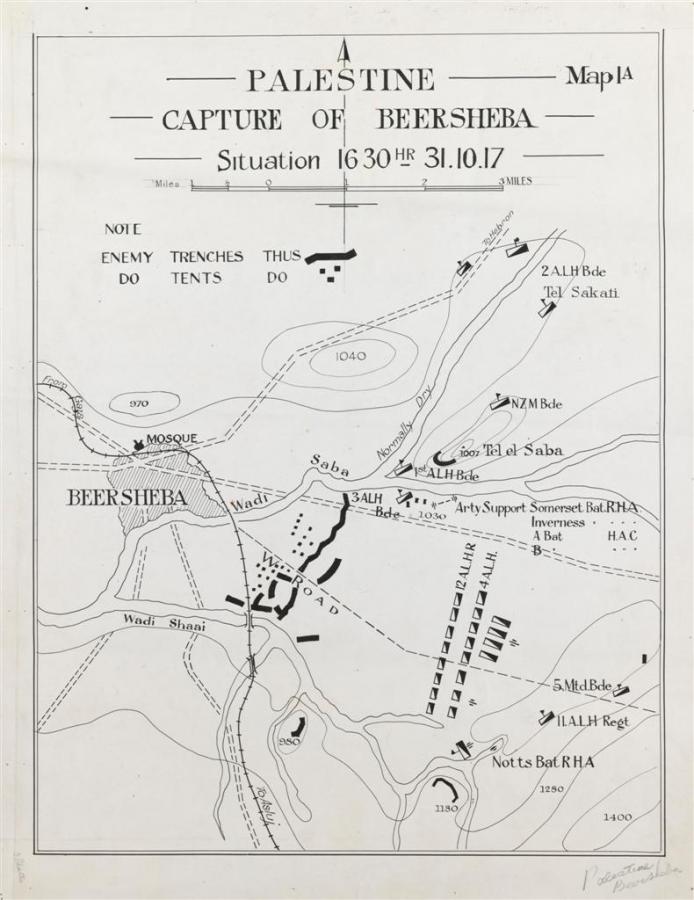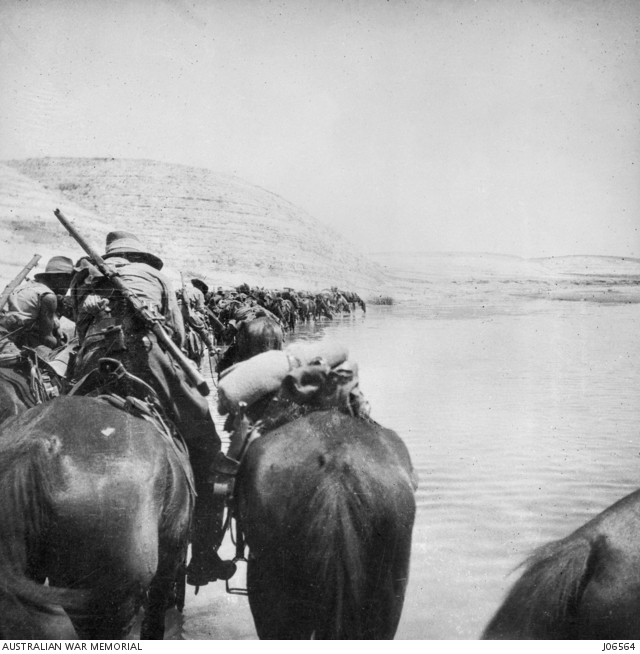Sources for the Battle
In addition to personal accounts, we have some official sources for the Battle.
Source 1: military map

Palestine: Capture of Beersheba (RC055071)
Source 2: after-action report
Lieutenant Colonel Donald Cameron was the Commanding Officer of the 12th Australian Light Horse Regiment. After the battle of Beersheba on 31 October 1917 he wrote his after-action report, extracts of which are transcribed below. You might find this account more meaningful if you can refer to the military map above.
12th Australian Light Horse Regiment
Beersheba Post-Battle Report
31 October 1917
1545 Received orders to saddle up and get ready to move immediately. The Regiment had previously moved into the concentration area of Iswaiwin with the brigade at 1130 and off saddled, fed horses and men.
1600 General Officer Commanding 4th Light Horse Brigade sent for commanding officers and seconds-in-command. Orders were received that the 4th and 12th Light Horse Regiments would attack Beersheba at once.
1630 The 4th and 12th Light Horse Regiments deployed from a point one mile north of Pt 1280. The Regiment moved on Beersheba at the gallop. Heavy enemy rifle and machine gun fire developed on the left flank from the vicinity of 1180. This fire was silenced by artillery. On reaching a point about 100 yards from these trenches one Troop of "A" Squadron dismounted for action, and the remainder of the Squadron galloped on, leaving the trenches on the right. "B" and "C" Squadrons followed this route. The trenches were left to the Troop that dismounted. The Regiment, less 1 troop, kept straight on to Beersheba. "A" and "B" Squadrons less 1 troop entered Beersheba along the Asluj - Beersheba road. Both Squadrons entered Beersheba in a body. A party of 6 men galloped in front General Headquarters (Turkish). The whole rallying in the main body while Captain Jack Rupert Cyril Davis on the northern outskirts turned about and held up the enemy force escaping in a northerly direction. The greater part of the enemy immediately surrendered. 9 Guns attempted to escape but were retaken complete.
Consolidation: All prisoners were rounded up at the railway and counted. Defensive positions were taken up at the pumping station and preparations made for all round defence. Major Eric Montague Hyman consolidated the redoubt east of Beersheba in anticipation of a counter attack from the south-west and held the positions all night. A patrol of 8 men was sent out at 2300 and made a reconnaissance in a south-west direction returning at 0300 bringing in 23 prisoners and reporting "All clear."
In all, 38 Officers and 700 Other Ranks were taken, 9 guns, 3 machine guns and a large quantity of various war material including rolling stock, transport vehicles and animals were captured.
Write
With detailed accounts like this one, it can help to make a summary of the most important details. Pull out the key details and write in one paragraph.
Draw
On the military map (source 1 above), plot the main movements described in this report.
Source 3: photographs
An aerial view of Beersheba as photographed from an aircraft of No 1 Squadron, Australian Flying Corps.
Australians draw water from a deep well near Beersheba, while Bedouins look on.
Australian Light Horse Regiments advancing towards Beersheba, Palestine 1917.



